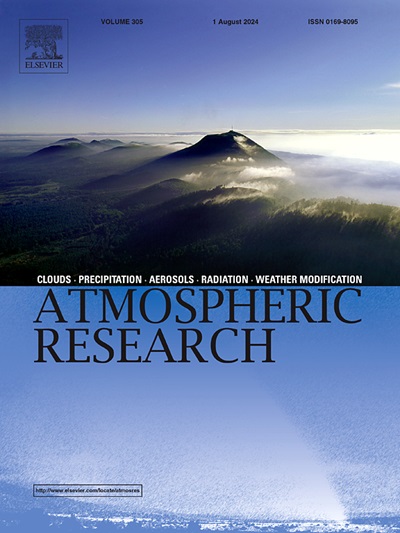Persistent O3 pollution over the North China Plain during the advancement of East Asian summer monsoon: Process analysis and interannual difference
IF 4.5
2区 地球科学
Q1 METEOROLOGY & ATMOSPHERIC SCIENCES
引用次数: 0
Abstract
The North China Plain (NCP) experiences the most severe persistent (≥3 days) ozone pollution (POP) across China. The study investigates the POP events during the advancement of EASM using the regional climate-chemistry-ecology model RegCM-Chem-YIBs. Summers from May to August are divided into the Meiyu-flood (MYF) period, and the periods before and after. Over the past ten years, most POP events occurred in the MYF period and its preceding period, with the longest duration and highest intensity during the MYF period. A notable peak was observed in 2017, with a significant increase in POP frequency across all three monsoon periods. Process analysis and sensitivity experiments for the 2017 events were conducted to elucidate the underlying mechanisms. In the PreF period, POP events are associated with the Baikal ridge and a high-pressure system over the NCP region. Chemical reactions, vertical advection, and turbulent transport facilitate the accumulation of surface O3, while horizontal advection has a negative effect. The most severe POP events occur in the MYF period, driven by a stable and strong Baikal ridge and a relatively weak Western Pacific Subtropical High (WPSH). Local chemical reactions and advections contribute significantly to these events. In the PostF period, POP events are rare due to a significant decrease in solar radiation. Compared to 2016, 2017 featured a stronger and earlier-established Baikal ridge and a weaker, later-jumped WPSH, leading to an increase of 2.0–2.3 ppb hr−1 in the O3 chemical production rate during early summer. Our findings indicate that the timing of the Baikal ridge establishment and the WPSH's strength and movement significantly influence POP events over the NCP. Interannual differences in the EASM process can modulate local atmospheric circulation and determine POP frequency.

东亚夏季风推进过程中华北平原持续O3污染:过程分析及年际差异
华北平原(NCP)经历了中国最严重的持续(≥3天)臭氧污染(POP)。利用区域气候化学-生态模式regcm -chem - yib,研究了东洋气旋推进过程中的POP事件。5月至8月的夏季分为梅雨期和梅雨期前后。在过去十年,大部分持久性有机污染物事件发生在MYF期及其之前,其中MYF期持续时间最长,强度最高。2017年观测到一个显著的峰值,在所有三个季风时期,POP频率都显著增加。对2017年的事件进行了过程分析和灵敏度实验,以阐明潜在的机制。在PreF期,POP事件与贝加尔湖脊和NCP地区的高压系统有关。化学反应、垂直平流和湍流输运有利于表面O3的积累,而水平平流则有不利影响。最严重的POP事件发生在MYF期间,由稳定而强大的贝加尔湖脊和相对较弱的西太平洋副热带高压(WPSH)驱动。局部化学反应和平流对这些事件起着重要作用。在f后时期,由于太阳辐射显著减少,POP事件很少发生。与2016年相比,2017年贝加尔湖脊更强、建立时间更早,而WPSH更弱、跳跃时间更晚,导致初夏臭氧化学物质产量增加2.0-2.3 ppb hr−1。研究结果表明,贝加尔湖脊的形成时间和副热带高压的强度和运动显著影响了北太平洋地区的POP事件。EASM过程的年际差异可以调节局地大气环流并决定POP频率。
本文章由计算机程序翻译,如有差异,请以英文原文为准。
求助全文
约1分钟内获得全文
求助全文
来源期刊

Atmospheric Research
地学-气象与大气科学
CiteScore
9.40
自引率
10.90%
发文量
460
审稿时长
47 days
期刊介绍:
The journal publishes scientific papers (research papers, review articles, letters and notes) dealing with the part of the atmosphere where meteorological events occur. Attention is given to all processes extending from the earth surface to the tropopause, but special emphasis continues to be devoted to the physics of clouds, mesoscale meteorology and air pollution, i.e. atmospheric aerosols; microphysical processes; cloud dynamics and thermodynamics; numerical simulation, climatology, climate change and weather modification.
 求助内容:
求助内容: 应助结果提醒方式:
应助结果提醒方式:


